Artist Project: Nicole Lenzi
My main interest as an artist is to push the boundaries of how to see and experience drawing. To this end, I question how drawing and space can each affect and redefine the other. Avis Newman’s idea, “a mark is a sign of thought,” informs my practice. I explore an expanded notion of drawing, one in which the medium opens up into a reciprocal dialogue with its surroundings. My multi-dimensional works are based on the tenets of Taoism. The Taoist fluctuation between opposites acts as a propeller for my drawings, expanding it into a gallery space. The contrasting male and female elements interplayed in my works are metaphors for the philosophy’s many facets. By following the principles of this Eastern philosophy as I work, a drawing effloresces and a flow of things emerges amongst art and architecture. I seek balance in the spaces in between for greater reflection.
Avis Newman writes that drawing is “as close to the action of an artist’s thought as one can get.” The mark is the first attempt of translating an idea. In my works, the materials and methods used to make marks are questioned. They are made with string, tape, tiles, moldings, shelving units, shadows, and anything else that relates to a given environment. I paint shadows and mark on materials to transcend them past what they literally are. Drawing with materials opens the door to new ways of perceiving space and experiencing mark making.
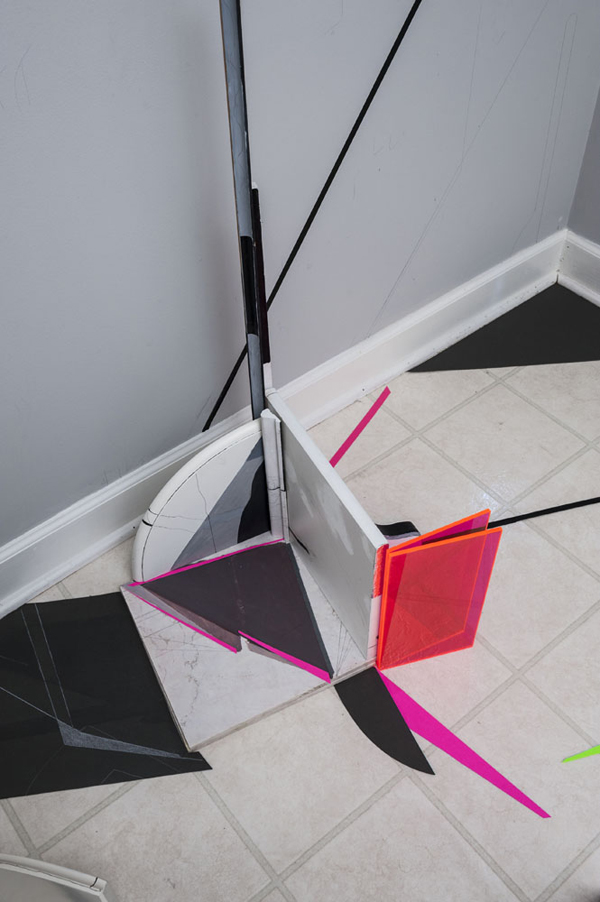
Nicole Lenzi, Conglomerate Hot Pink No. 2, 2012, shelving units, moldings, tiles, acrylic, pencil, paper, plexiglass, 37 x 50 x 45in
My work is influenced by Lao Tzu’s Taoist script the “Tao Te Ching” and Luce Irigaray’s contemporary feminist work, “Elemental Passions.” Both works poetically contemplate how opposites can be balanced in terms of gender relations. This is gradually achieved by overcoming the closed masculine and yielding to the softer, open feminine side of the Tao. Hard and soft marks, tones, shapes, and edges signify male and female in my work. They interact in varying states of tension and flow. This push and pull action perpetuates a drawing outward into an environment. Moments of stillness and balance occur when conflicting art elements align and harmonize.
Small scale combinations of materials, called Conglomerates, set the stage for dialogues between male and female. They are built at intersection points in a room. Opposites interplay in these structures. High and low end materials come together; laminate, glass, plastic, moldings, shelving units, and, tiles, and marble. Diverse edges, shapes, and tones are juxtaposed and rest on the floor, leveling any hierarchy. Shadows are recorded onto materials and floor in many shades of gray.
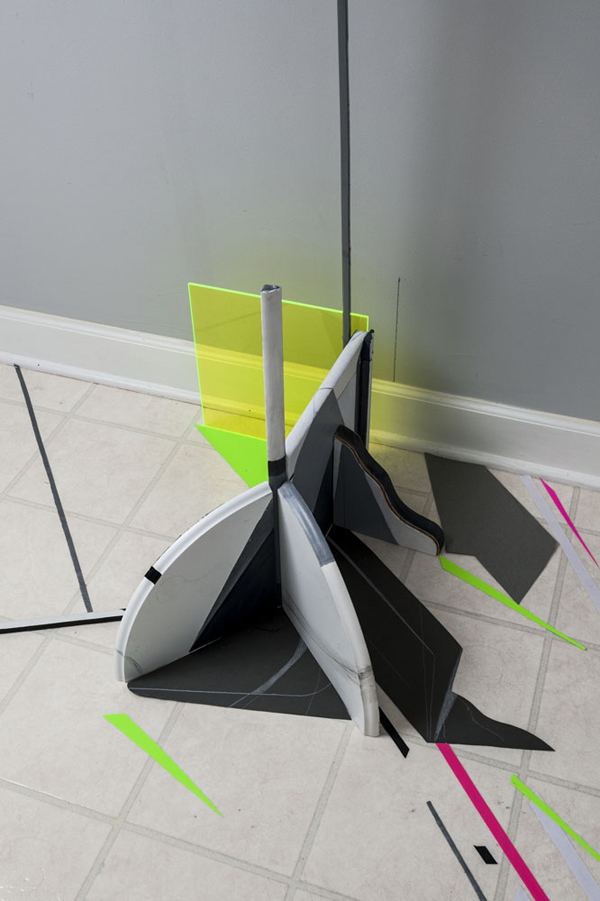
Nicole Lenzi, Conglomerate Neon No. 2, 2012, shelving units, moldings, tiles, acrylic, pencil, paper, plexiglass, 47 x 60 x 55in
The feminine overcomes the masculine in Conglomerates to expand a drawing into its surroundings. Moldings are placed in between materials to act as flexible joints; metaphorically easing tension between male and female. Marks are drawn over and under surfaces, shapes, and shades to forge connections and dialogues. Rounded feminine curves invite unrestricted movement to marks while upright masculine edges cause abrupt stops. Refraction is employed to break lines past these barriers. This action extends them outward into the gallery.
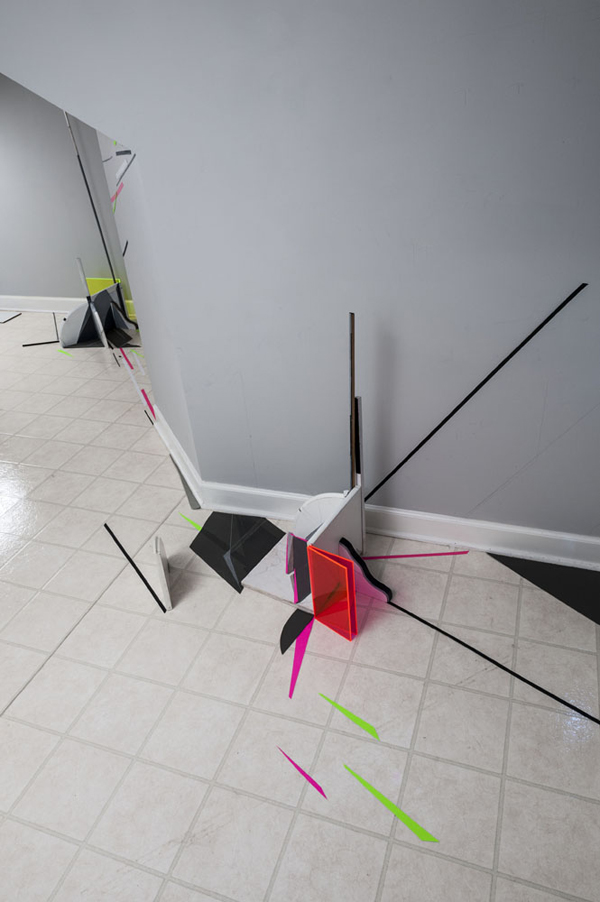
Nicole Lenzi, Green to Red, 2012, shelving units, moldings, tiles, acrylic, pencil, paper, plexiglass, 87 x 100 x 95in
My installations, or spatial drawings, follow along the same lines; as contrasting edges, lines, shapes, and tones are interrelated in a room. A flow of things emerges when these divergent elements line up. Echoes and harmonies stir between opposites throughout a space. The boundaries between what is art and architecture blur. Each installation focuses on a particular aspect of Taoism. By using Eastern philosophy as the conceptual base of my work, drawing in space is very improvised and experimental. The unexpected is welcome and lead a drawing into new territories. A new space offers distinct and unexpected layouts, angles, lighting conditions, and materials to respond to that push the boundaries of how to see and experience the medium.
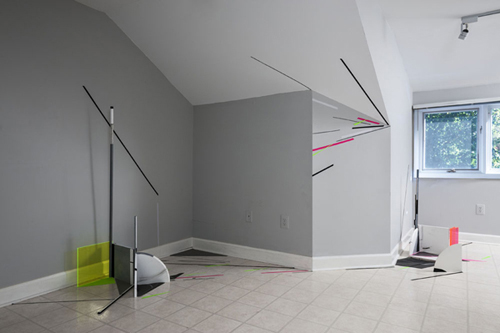
Nicole Lenzi, Green to Red, 2012, shelving units, moldings, tiles, acrylic, pencil, paper, plexiglass, 87 x 100 x 95in
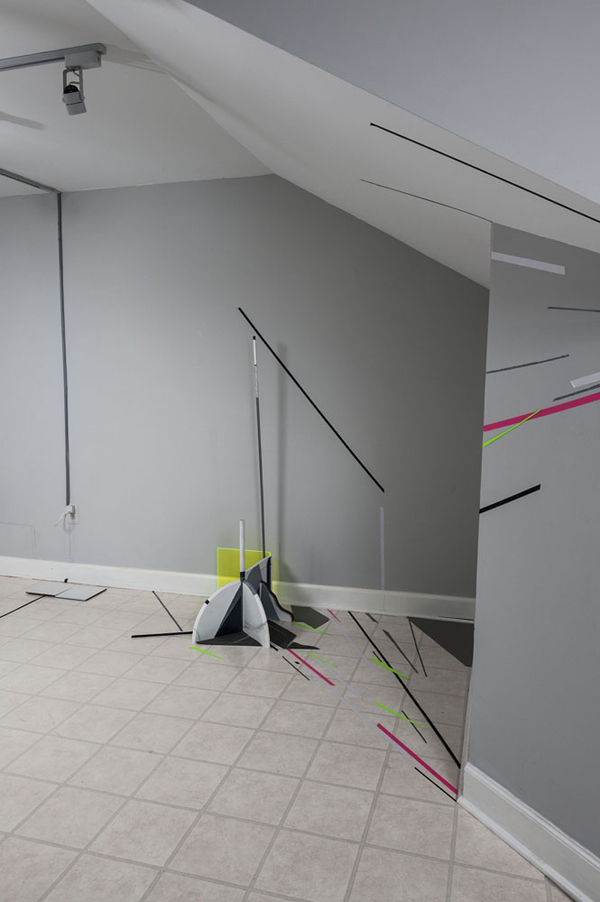
Nicole Lenzi, Green to Red, 2012, shelving units, moldings, tiles, acrylic, pencil, paper, plexiglass, 87 x 100 x 95in
Like the fluctuating Tao, relationships in my works shift over time in the spaces in between. These changes open up new dialogues, so that drawing and space continue to extend and redevelop the other.
Tags: Journal